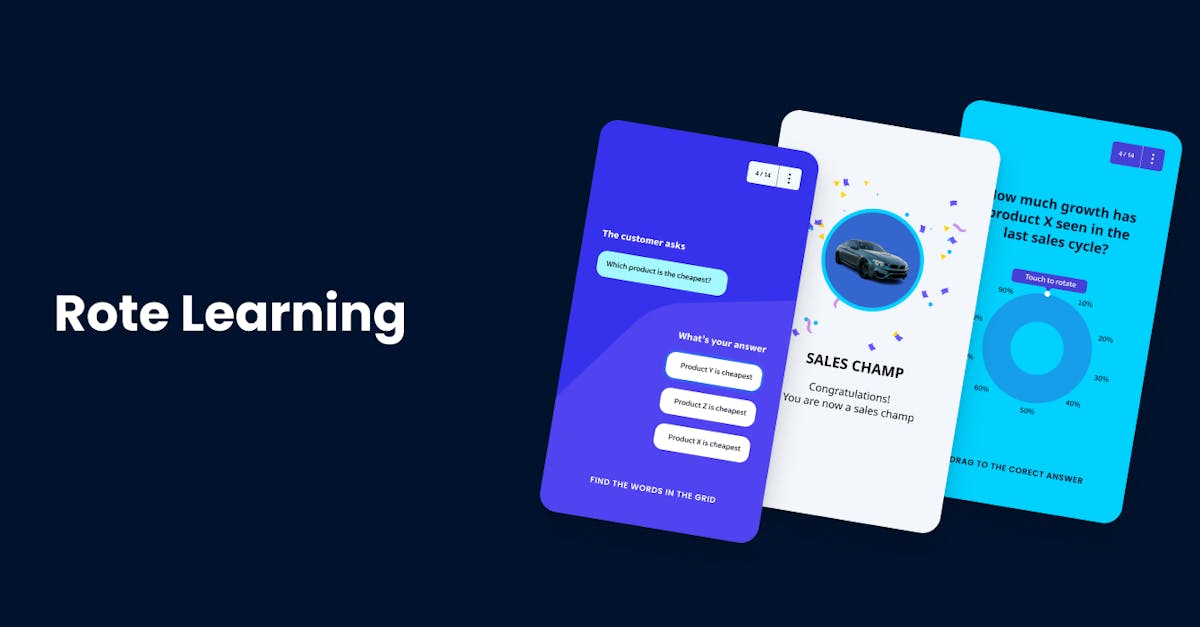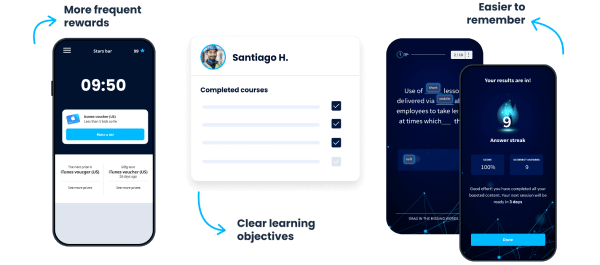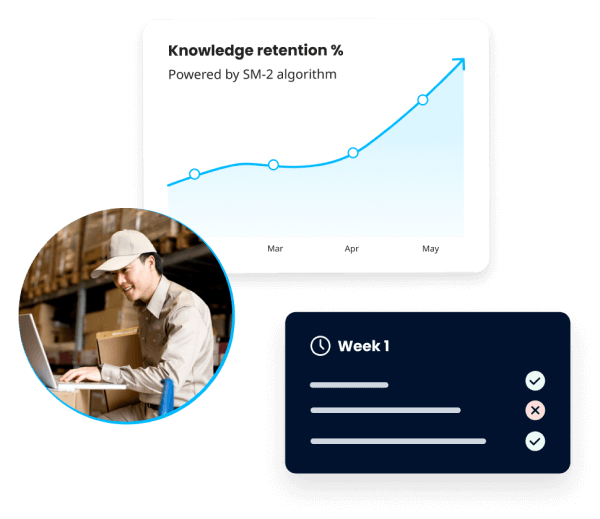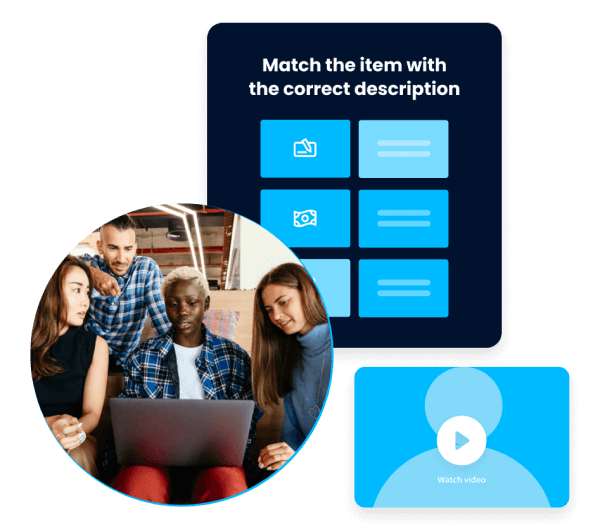Is rote learning effective for workplace training?

Rote learning or repetition-based learning is one of the most common ways we learn. We learned the alphabet, numbers, and the multiplication table this way, but does this strategy still work for corporate learning? In this article, we’ll explore the ins and outs of rote learning through concrete examples and how it’s still relevant to all kinds of learning today.
What is rote learning?
The American Psychological Association (APA) defines rote learning as “memorization by repetition without any elaboration…” Think about when you had to memorize the alphabet as a child, you didn’t need any explanation, you simply memorized the symbols. It’s easier to remember rote learning as two parts:
- Memorization: the first step is committing information to memory through reading, speaking, hearing, visualizing, etc.
- Repetition: the next step is reiterating and reabsorbing information in intervals until memorized

Rote learning examples
There are a lot of ways to memorize information and I’m sure you remember some of these strategies when you were in school. Depending on a learner’s learning style, they may approach rote memorization differently.
- Reading aloud: auditory or aural learners are those that process information better through hearing sound and rhythm. Speaking or even singing different intonations and expressions helps reinforce memory, that’s why rhymes are a great way to remember information!
- Writing: some learners memorize information by jotting notes down or repeatedly writing down the same sentences over and over. Remember, this is how you learned your alphabet too, with the help of muscle memory.
- Visualizing: visual learners are learners that absorb information better through representations like charts, pictures, and tables or through colors. Visualizing knowledge or even assigning colors to important terms is a great way to memorize information.
- Using flashcards: flashcards are a studying staple and rote learning in action. The best way to use flashcards is to repeat the terms or info your learners are having the most difficulty remembering.

With all of these said, the APA explains that because rote learning is strictly memorization, it may result in poorer information retention. Simply, brute forcing your way through memorization has never proven to be effective in the long term. That’s why cramming for exams is never recommended! So, why still talk about rote learning? And more importantly: is rote learning effective?
Is rote learning effective?
It’s important to note that rote learning is a base technique. And as one of the oldest learning strategies, it’s evolved and developed over the years. Advances in teaching and learning technologies have built on the foundations of rote learning and memorization to create effective training strategies for modern learners. But, why is rote learning so ineffective?

By definition, rote learning doesn’t account for context and comprehension. In other words, it doesn’t look at the big picture. The way our brain works is that higher mental abilities rely on understanding the relationships between information. We have to understand the whys and hows of what we’re learning to fully absorb it long-term. This is called meaningful learning.
What is the difference between rote learning and meaningful learning?
Meaningful learning tells us that information doesn’t exist in a vacuum. Think of your brain as a filing cabinet or a closet. If information isn’t correctly labeled in your head, it’s going to get lost. Meaningful learning pieces information together so that you’re building on knowledge rather than just throwing them together. This is more effective than simple memorization because your learners are using more of their brain power.

Rote learning still has a part to play here, you still need to memorize information. But building on it with critical thinking, categorization, interpretation, and organization will help long-term memory, and ultimately, learning.
Spaced repetition and microlearning: the evolution of rote learning
And so, over the years technology and learning studies have improved on the basics of rote learning by using the principles of meaningful learning. Two strategies have come up that gained popularity because of their effectiveness in modern workplace learning. The first is called microlearning and the second is spaced repetition.
These two strategies have formed the backbone of elearning because they address some of the most common barriers to learning for modern learners like short attention spans, accessibility, and knowledge retention. So, let’s get into each and see how they’ve improved rote learning.
What is microlearning?
Microlearning is all about creating digestible, bite-sized but highly targeted learning content for a more memorable learning experience. By breaking information down into chunks, learners can easily absorb information which increases the likelihood of knowledge retention. Most microlearning courses make use of interactive media like quizzes and games so that learners are actively engaged.

Microlearning tools, like EdApp for example, are mobile-first systems, which means you can deliver your training materials directly to learners’ phones and other devices. This opens up the possibility of self-paced learning, which is crucial to employees with hectic schedules. Microlearning improves rote learning by making sure lessons aren’t just memorized but absorbed in interesting and fun ways.
What is spaced repetition?
Think of spaced repetition as strategic rote learning. Spaced repetition is based on the spacing effect or the observation that information is remembered more clearly when spaced out. It’s easier to remember things when you repeat them far apart than close together. Studies on the spacing effect date back to 1885 credited to Hermann Ebbinghaus in a memory study called “Memory: A Contribution to Experimental Psychology.”

Here’s how you can visualize the effect: EdApp makes use of spaced repetition through its Brain Boost feature. What it does is that for every course your learners take, the tool will automatically send out follow-up quizzes in set intervals. These intervals adapt to the performance of your learners and send out quizzes on areas they have trouble with! It’s rote learning at the next level.
Use microlearning and spaced repetition for workplace training
As mentioned, elearning has revolutionized traditional learning principles like rote memorization. EdApp, among many other learning platforms, has democratized learning at work by making it accessible, enjoyable, and easy to use. On EdApp, you can create your courses with microlearning and spaced repetition already integrated into the design.

So, to answer the question, is rote learning still effective in the workplace? With the right tools and strategies, it’s an absolute yes. See for yourself and try an EdApp ready-made elearning course for your team and see the results.
Level up rote learning with EdApp today! Sign up now—it’s free forever.
Author
Alec Bailon
Alec is an eLearning expert for EdApp, a pioneer LMS that designs creative mobile workplace training solutions. On the off days, they enjoy cooking, reading, or finding a live show or play to watch.
